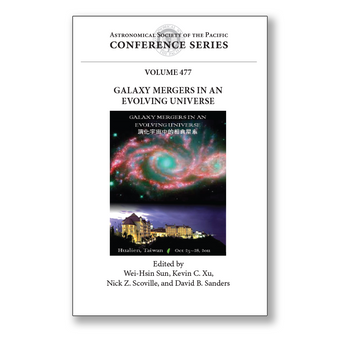Vol. 477 – Galaxy Mergers in an Evolving Universe
Your purchase of this volume includes a printed copy and electronic access. With your purchase of this title online, you will receive email instructions on how to access the e-Book version. If you wish to use our printable order form and mail or fax it to us, you will need to include your email address on this form in order to receive electronic access to the purchased volume(s).
Volume CS-477
Editor(s): Wei-Hsin Sun, C. Kevin Xu, Nick Z. Scoville, and David B. Sanders
Print ISBN: 978-1-58381-838-1
e-Book ISBN: 978-1-58381-839-8
Published: 2013
Galaxy mergers play a vital role in the evolution of galaxies by building more massive galaxies, triggering starburst and AGN activity, and transforming spiral galaxies into elliptical galaxies. At the same time, accretion of dark matter and intergalactic gas (IGM) are also significant to the cosmic evolution of the dark matter halos and galaxies within them.
The purpose of this workshop was to bring together observational and theoretical researchers in this field to synthesize recent results addressing major unanswered questions. What are the frequencies and basic characteristics of mergers in different cosmic epochs? Are most of high-redshift extreme-starbursts and AGNs mergers, or are they galaxies with significant accretion of cold IGM gas? Are nearly all elliptical galaxies formed through mergers? Do mergers and normal disk galaxies have different star-formation/gas-density relations (Kennicutt-Schmidt law) and stellar initial mass functions? There have been major advances in both theory (higher resolution simulations with radiative transfer and modeling star formation, IGM accretion, and nuclear accretion) and observations (Spitzer, Akari, and Herschel observations constraining merger rates, star formation histories, and galaxy mass and luminosity distributions at high redshifts). This meeting sought to integrate these many advances, identify major uncertainties, and set future directions for high-redshift galaxy evolution research in the era of ALMA and JWST.
For more information about this publication and other ASP Conference Series Proceedings, click here (a new browser window will open).


